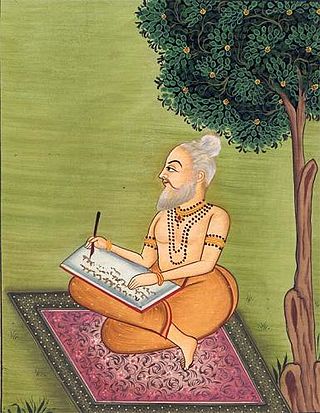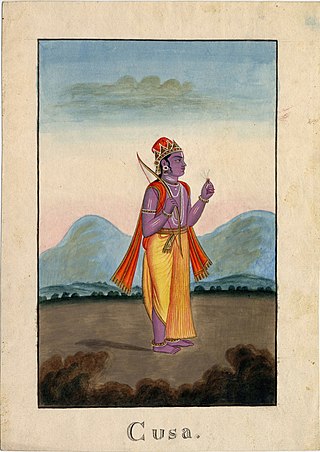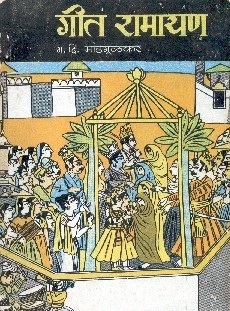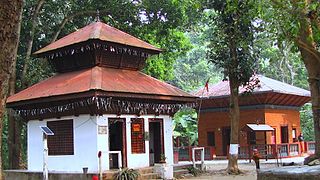
The Ramayana also known as Valmiki Ramayana, as traditionally attributed to Valmiki, is a smriti text from ancient India, one of the two important epics of Hinduism known as the Itihasas, the other being the Mahabharata. The epic narrates the life of Rama, a prince of Ayodhya in the kingdom of Kosala. The epic follows his fourteen-year exile to the forest urged by his father King Dasharatha, on the request of Rama's stepmother Kaikeyi; his travels across forests in the Indian subcontinent with his wife Sita and brother Lakshmana; the kidnapping of Sita by Ravana, the king of Lanka, that resulted in war; and Rama's eventual return to Ayodhya along with Sita to be crowned king amidst jubilation and celebration.

Valmiki was a legendary poet who is celebrated as the traditional author of the epic Ramayana, based on the attribution in the text itself. He is revered as Ādi Kavi, the first poet, author of Ramayana, the first epic poem.

Sugriva is a character In the ancient Indian epic Ramayana. He is the younger brother of Vali, whom he succeeded as ruler of the vanara kingdom of Kishkindha. Rumā is his wife. He is a son of Surya, the Hindu deity of the sun. As the king of the vanaras, Sugriva aided Rama in his quest to liberate his wife Sita from captivity at the hands of the rakshasa king Ravana.

Lava and his elder twin brother Kusha, are the children of Rama and Sita in Hindu tradition. Their story is recounted in the Hindu epic, Ramayana and its other versions. He is said to have a whitish golden complexion like their mother, while Kusha had a blackish complexion like their father.
Raghuvaṃśa is a Sanskrit epic poem (mahakavya) by the celebrated Sanskrit poet Kalidasa. Though an exact date of composition is unknown, the poet is presumed to have flourished in the 5th century CE. It narrates, in 19 sargas (cantos), the stories related to the Raghu dynasty, namely the family of Dilipa and his descendants up to Agnivarna, who include Raghu, Dasharatha and Rama.

Sita, also known as Siya, Janaki, Maithili, Vaidehi and Bhumija, is a Hindu goddess and the female protagonist of the Hindu epic, Ramayana. She is the consort of Rama, the avatar of the god Vishnu, and is regarded as an avatar of Vishnu's consort, Lakshmi. She is also the chief goddess of Rama-centric Hindu traditions. Sita is known for her dedication, self-sacrifice, courage, and purity.

Avani is a small village in Mulabaagilu taluk, Kolara district in Karnataka, India, about ten miles from Kolar Gold Fields. The village is located at 32 km from Kolara, the district centre and 13 km from Mulabaagilu, the Taluk headquarters. It is a popular location for rock climbing.

Kusha and his younger twin brother Lava were the children of Rama and Sita. Their story is recounted in the Hindu epic, the Ramayana. Hindu traditions claim he ruled the entire region of Kashmir, Indus River and Hindu Kush as frontier lands of India known as Hindu Kush Kshetra and founded the city of Kashmir in the valley and Kasur with Lavapuri of Lava in base lands, though local lore contends Kasur was founded in 1525 by Pashtun migrants. His brother Lava is traditionally believed to have founded Lavapuri.

Pulpally is a mid-sized town in Wayanad District of Kerala, India.Pulpally also known as 'The land of black gold'. Pulpally is also renowned for its pure wild Wayanad honey. The famous Seetha devi temple in Kerala is situated on Pulpally. Geographically a small town in Sultan Bathery Taluk and a "Grama Panchayath" under the local self governance system. It is about 24 km from Sultan Bathery, and is almost surrounded by forest. The main source of income is agriculture.
Luv Kush is an Indian television series that ran from 1988 to 1989. It was created, written, produced, and directed by Ramanand Sagar. It is a follow-up Ramayan, featuring mostly the same cast and production crew. Luv Kush covers the last book — the Uttarakāṇḍa — of the ancient Indian epic Ramayana, following Rama's coronation, especially focusing on his children, twins Kusha and Lava.

Naimiṣāraṇya, also referred as Naimisha is a sacred forest frequently mentioned in Puranic literature, as well as both the Ramayana and the Mahabharata. It is regarded to be the place where the Puranas had been narrated for the first time, before a large gathering of sages. The ancient forest corresponds to modern day Nimsar, situated along the Gomati river in the Sitapur district of Uttar Pradesh, India.

Lava Kusa is a 1963 Indian Hindu mythological film directed by C. S. Rao and his father C. Pullayya. The film was scripted by Sadasivabrahmam, Samudrala Sr. along with C. S. Rao and C. Pullayya. The film was produced by Sankara Reddy under Lalita Sivajyothi Films. Lava Kusa is the first full-length colour film of Telugu cinema.

Geet Ramayan is a collection of 56 Marathi language songs chronologically describing events from the Indian Hindu epic, the Ramayana. It was broadcast by All India Radio, Pune in 1955–1956, four years before television was introduced in India. Written by G. D. Madgulkar and the songs being composed by Sudhir Phadke, Geet Ramayan was acclaimed for its lyrics, music and singing. It is considered a "milestone of Marathi light music" and the "most popular" Marathi version of Ramayana.

Lava Kusa: The Warrior Twins is a 2010 animation film written and directed by Dhavala Satyam as a joint venture of Kanipakam Creations with RVML Animation.

Sri Rama Rajyam is a 2011 Indian Telugu-language devotional film directed by Bapu who co-wrote the film with Mullapudi Venkata Ramana, and produced by Yalamanchali Saibabu. The film stars Nandamuri Balakrishna, Nayanthara, Akkineni Nageswara Rao, Srikanth, and its music was composed by Ilaiyaraaja, which won him Nandi Award for Best Music Director. Sri Rama Rajyam is a reboot of the 1963 blockbuster film Lava Kusa.

Seeta is a 1960 Indian Malayalam-language film, directed and produced by Kunchacko, based on the Ramayana epic. The film stars Prem Nazir, Kusalakumari, Thikkurissy Sukumaran Nair and Hari. The musical score is by V. Dakshinamoorthy. Seetha was a box office hit.

Kanchana Sita is a 1977 Indian Malayalam feature-length film scripted and directed by G. Aravindan. A mythological film, its story was adapted from C. N. Sreekantan Nair's play of the same name, which is a reworking of Valmiki's Ramayana.
Kurungaleeswarar Temple is a historically important Hindu temple in the neighbourhood of Koyambedu, Chennai, India. The temple encloses a large tank and dates from the Medieval Chola period.

Lav Kush is a 1997 Indian Hindu mythological film, produced by Dilip Kanikaria under the Devyank Arts banner and directed by V. Madhusudhana Rao. It is based on Valmiki's Uttar Ramayan from the Indian epic Ramayana. The music of the film was composed by Raamlaxman. It stars Jeetendra as Rama, Jaya Prada as Sita, Arun Govil as Lakshmana, Dara Singh as Hanuman and Pran as Valmiki.

Valmiki Ashram is a Hindu Balmiki temple situated in Chitwan district of Nepal, inside Chitwan National Park. It is close to the Triveni Dham where Tamasa, Sona and Sapta Gandaki rivers meet. Deities worshipped here include Rama, Sita, and Valmiki. The festival of Rama Navami is also celebrated here.















